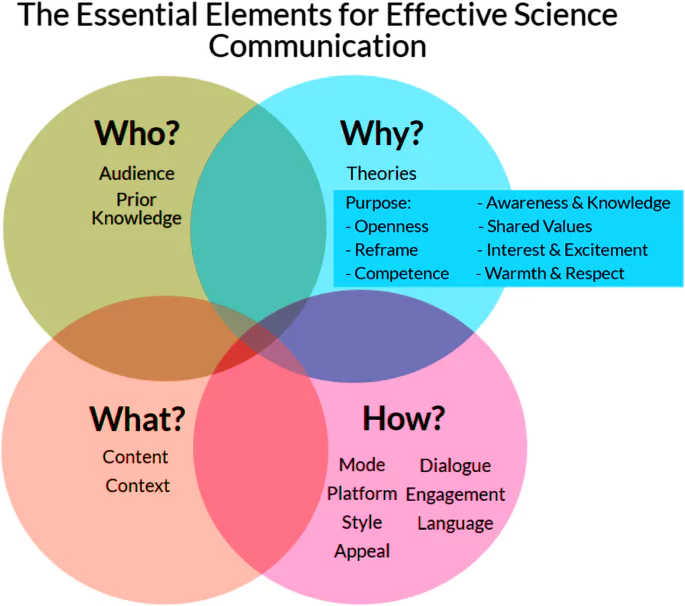Context:
The COVID-19 pandemic exposed serious lacunae in the reliable communication of scientific information in India – particularly vis-a-vis accurate data reporting, vaccine hesitancy, and prediction of the resurgence of infections.
What is Science Communication?

- Science communication is the practice of informing, raising awareness of science-related topics to a general audience in a meaningful, comprehensible, and useful manner.
-
For Example of Science communication:
-
- Climate Change Communication: Scientists over the years have been communicating the risks and impacts of climate change to the masses. This has significantly influenced public attitudes and government policies toward sustainable practices.
- Discovery of DNA: When Watson and Crick communicated their complex findings of DNA helix in an accessible way, enhancing the understanding of genetic mechanisms globally.
- Public Health Campaigns: Be it AIDS, Ebola or more recently, COVID-19, public health campaigns have been instrumental in disseminating crucial information, debunking myths, and promoting preventive actions.
Need For Science Communication in India
- Diffusion of Scientific Information: As India is technologically advancing and entering the information age, scientific information needs to be diffused to the non-scientific community.
- It will help to debunk myths around science and promote evidence-based knowledge.
- Addressing Local Challenges: It is needed to address different regions and communities’ specific needs and concerns.
- Inspiring the Next Generation: Sharing success stories of Indian scientists and engineers will help inspire young minds to pursue STEM careers and foster national pride.
- Showcase of Technological Prowess: It is needed to showcase real-world applications of Indian technology, like space missions, medical breakthroughs, or agricultural innovations, connecting science with daily life.
Indian Government’s Previous Science Communication Efforts
- Establishment of Publications & Information Directorate (PID): In 1951, the Indian government founded the PID under the Council of Scientific and Industrial Research (CSIR).
- PID played a pivotal role in science communication, publishing national science magazines in Hindi (Vigyan Pragati), English (Science Reporter), and Urdu (Science Ki Duniya).
- Birla Industrial and Technological Museum: In 1959, the government established the museum in Calcutta to define India’s scientific heritage and promote science education.
- Constitutional Amendment for Scientific Temper: The 42nd amendment to the Constitution in 1976 introduced Article 51 A(h), stating that every Indian citizen must develop a scientific temper, humanism, and the spirit of inquiry and reform.
- Inclusion of Science Popularization in Five Year Plan: During the sixth Five Year Plan (1980-1985), the importance of popularizing science and fostering scientific thinking in India was recognized.
- The National Council for Science and Technology Communication (NCSTC) was established to address these objectives during this period.
- Creation of Vigyan Prasar: In 1989, the Department of Science and Technology established Vigyan Prasar, an autonomous organization dedicated to enhancing science communication and education in the country.
Contemporary Science Communication Interventions in India
- Establishment of CSIR-National Institute of Science Communication and Policy Research (CSIR-NIScPR):
- In 2021, the Indian government created CSIR-NIScPR by merging two existing institutions, reflecting a contemporary approach to science communication.
- Involvement of National Science Funding Agencies:
- Science communication divisions within national science funding agencies are actively engaged in communication activities such as issuing press releases, conducting social media campaigns, and supporting exhibitions and popular lectures.
Way Forward
- Formal Education and Training: Introduce master’s and doctoral programs in science communication to foster a cadre of proficient communicators well-versed in India’s diverse contexts.
- Integrating Communication with Scientific Research: This includes involving scientists in science communication, integrating communication into research and recognizing and rewarding scientists’ contributions.
- Professional Organization for Science Communication Frameworks: A professional organization needs to be established that collaborates with governmental bodies, stakeholders, and experts to formulate comprehensive science communication frameworks.
- These frameworks should encompass diverse disciplines, media formats, and demographic groups.
Conclusion
By addressing current deficiencies and adopting a forward-thinking approach, India has the opportunity to establish a robust science communication ecosystem that can reduce and bridge the gap between the scientific community and society.
Also Read: World Science Day For Peace And Development 2023
News source: The Hindu
![]() 22 Jan 2024
22 Jan 2024
